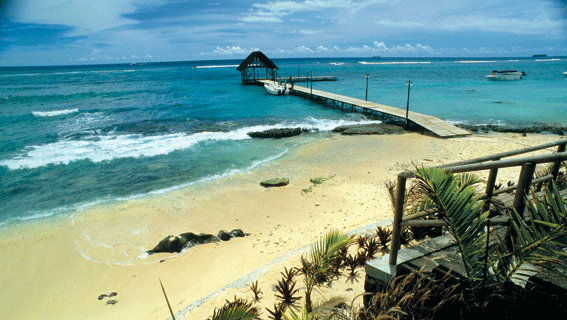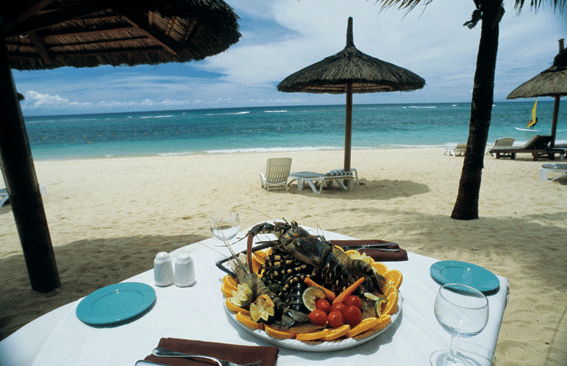
![]() Travel
Travel
 Mauritius
Mauritius
Emerald Of the Indian Ocean
Glittering beaches bounded by coral reefs, turquoise lagoons, verdant plateaux and abundant waterfalls are just some of the features that make Mauritius an island haven.
By: Veronica Maria Garbutt
Add to this a melting pot of European, Asian and African cultures, friendly hospitable people that live in harmony in the balmy tropical climate. Combine with an abundance of seafood, shopping, watersports, art and music and voilà – you are all set for an intriguing and enjoyable adventure in the Emerald of the Indian Ocean.
With an area of just over 700 square kilometres Mauritius lies just north of the Tropic of Capricorn at 58ºE. The republic comprises Mauritius itself along with Rodrigues island, the Cargados Garayos Archipelago and the two almost uninhabited Alalega islands. Until recently sugar was the mainstay of the economy but the agricultural sector has now diversified into tea, tobacco, corn, potatoes, tomatoes and flowers. Industry success has lately been in textiles, knitwear and footwear manufacture. Tourism too is now a major earner, and the island has recently been promoted as an offshore banking centre.
It was Arab seamen who made the first recorded discovery of the island when they landed there in CE 975. They named it Dinarobin, but left no evidence of their presence and it was not until 1507 that the Portuguese sailor Domingo Fernandez arrived. The Portuguese did not claim possession but renamed it Ilha do Cerne (Swan Island).
From 1598 – 1968 Mauritius had a colonial history. Just before the turn of the 16th century the Dutch Admiral van Warwyck dropped anchor off the southeast coast en route to the spice and silk markets of the Far East. He named the island after Prince Maurice of Nassau. Sugar cane was brought over from Jakarta in 1639 and bananas were introduced. To improve food stocks the settlers brought in geese, ducks, sheep, deer and other animals. And slaves were imported from the East Indies and Madagascar.
The Dutch colony, however, never really flourished. In 1658 the settlers abandoned Mauritius, moving to a station that they had established on the Cape of Good Hope. Some five years later the French arrived, renaming the island Ile de France. Settlement began in 1721 and 1735. Bertrand Francois Mahé de Labourdonnais became governor.
Known as the “Father of the Island” Labourdonnais introduced wheat and cotton, expanded the port facilities, built the first sugar mill and hospital and expanded the road network. By the late 18th century Mauritius was used as a base for pirates plundering British ships en route to the East Indies. Then in 1810 the British moved in on the corsairs and Mauritius. The 1814 Treaty of Paris gave the island along with the Seychelles and Rodrigues to the British.
The first British governor, Robert Farquhar, allowed the islanders to retain their French laws, language, culture and property. Under Farquhar sugar became the island’s raison d’etre, roads were constructed and Port Louis became a free-trade zone. Slavery was abolished in 1835 and some 200,000 indentured labourers immigrated from India in search of a better life.
By the early 20th century immigration had all but ceased and the Indian community became the majority group. In 1968 the island became independent but remained a British Commonwealth member. The highly regarded Sir Seewoosagar Ramgoolam, of Indian ancestry, became Mauritius’ first prime minister. And in 1992 the island became a republic with Veerasamy Ringadoo as the first president. Both French and English law from the basis of the country’s legal system.
East meets west and north meets south in Port Louis, the most multicultural town in Mauritius. At its heart lies Place d’Armes, a palm-lined avenue running from Government House to the Caudan waterfront complex in the port area. The complex is reminiscent of San Francisco’s Embarcadero with shops, cinemas, restaurants, a hotel and offices. It is built around the old British Customs House and several 18th century warehouses and you can take a cruise from the harbour.
Jummah Mosque, a delightful blend of Islamic, Indian and Creole architecture lies in the Chinese Quarter, features a spiral dome with heavy, intricately carved wooden doors inlaid with brass at the entrance. Five times a day the faithful are called to prayer by the muezzin in this cool, peaceful place and sermons take place between 10 and noon on Thursdays and Fridays.
Across the road Port Louis’ bustling market is a heady mix of colourful sights, sounds and tastes. For me the most interesting section was the herbalists domain where all manner of herbs are sold for therapeutic use. The cures are based on traditional Indian herbal medicine and generally take the form of leaves which are infused in hot water. Here you can find a remedy for stuttering, sadness, slimming and even overheating!
For museum buffs there are several to choose from. The Natural History Museum on Chaussée Street showcases a reconstruction of the dodo, the famous flightless bird which became extinct in the 17th century. At the Photography Museum you can leaf through an enormous archive of historical photos of the island. And if it is philately you are after, the Mauritius Postal Museum houses an impressive collection of local stamps as well as a replica of the old Port Louis telegraph office.
Racing fans might check out the racecourse, Champ de Mars, which hosts the Mauritius Turf Club. From May to November race meetings are held on Saturdays and the calendar highlight is in late August when the Marden Plate is run. Shoppers should visit the National Handcrafts Centre or La Maison de l’Artisan for finely crafted goods. Shells and shell products can be found at Argonaute. Cool tropical clothing with local flair is available at The Spot and Bongo, both on Royal Street.
Beyond the capital several attractions beckon. Just 15 minutes drive away lies Domaine les Pailles estate where you can explore the countryside in a lacquered horse-drawn carriage, on horseback or by quad bike. Jazz, mini golf, a children’s corner, a sugar train ride, a spice garden, restaurants and accommodation are all on offer here. But the pièce de resistance is the copy of the sugar mill which shows the sugar production process as it would have been in the late 18th century.
Moving eastwards some 7 km from the capital lies Pamplemousses, home of Sir Seewoosagar Ramgoolan Botanic Garden. The present gardens were named after the island’s first prime minister in 1988 but white wrought iron gates from the Grand Exhibition era mark the original entrance. Inside are over 500 plant species including some sixty varieties of palm. But what most visitors come for is the Lily Pond where the giant Amazon water lilies grow up to 1.5 metres in diameter, each one weighting up to 45 kg.
Heading north you will find the island’s best beaches around Trou aux Biches and Grand Baie. This is the “Creole Cote d’Azur”, main destination for locals and foreigners alike with an abundance of boutiques, restaurants and watersports on offer. The main hotels have facilities for diving, snorkelling, board sailing and waterskiing and many offer sailing and glass-bottom boat trips too.
Heading South from Port Louis don’t miss Eureka House, a magnificent Creole Mansion near Moka. Here you may dine on the terrace enjoying stunning views of the Mauritian landscape across the river valley. Other fine example of Creole houses include the town hall of Curepipe and the nearby Domaine des Aubineaux. At the latter you can sample Mauritian tea from a local plantation – a good way to beat the heat.
Over on the west coast Flic-en-Flac is the beach area to make for while on the east coast the old port town of Mahebourg is worth visiting for its Naval Museum. A few kilometres inland lies Domaine du Chasseur (Hunter’s Domain). Once a theatre of conflict between the French and the British, today it is a private nature reserve popular with hunters and eco-tourists. At the thatched restaurant you can sample delicious Creole dishes of roast venison with yams, carri dodo and chilli cakes.
Other natural wonders of the island include Black River Gorge National Park, Chamarel Waterfall and Chamarel Coloured Earth. This dramatic multi-coloured terrain is thought to have been caused by the uneven cooling of lava. In this area the denizens are predominantly Afro-Creole and you may even happen upon an impromptu sega dance performance. Mauritius is an all year round destination but if you plan on diving be sure to go between December and March when the aquamarine waters are at their best.